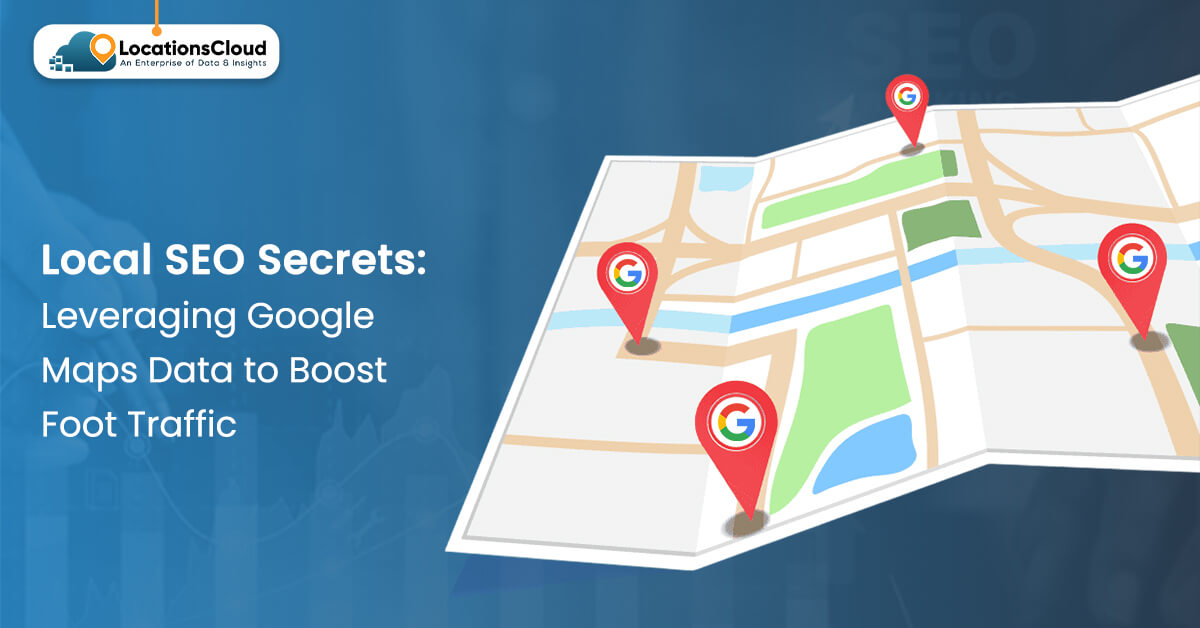
As mobile devices and instant information redefine the way consumers interact with businesses, Local SEO and Google Maps usage in particular comprise an invaluable strategy for any company with a physical location. Whether you run a single independent coffee shop, a chain of retail shops, or a dental practice, your presence on Google Maps will ultimately define your storefront success.
Along with revealing step-by-step Local SEO secrets, with a special focus on maximizing Google Maps, this guide will help you build visibility and trust while driving potential customers to your business.
What Is the Critical Role of Google Maps in Local Search?
- Increased Visibility: Google Maps is a highly popular platform for users seeking businesses in their vicinity. By optimizing your Google Maps listing, you can enhance your chances of ranking in local searches and increase visibility to prospective customers.
- High Purchase Intent: Users who utilize a service like Google Maps to search for local businesses often exhibit high purchase intent, indicating that they are typically ready to visit a store or purchase the business’s services. According to Google, 76% of people who perform a local search will see a company within 24 hours.
- Increased Credibility and Trust: A high-quality Google Maps listing is indicative of a legitimate and engaged business, thereby enhancing trust and credibility among prospective customers.
- Mobile First Indexing: Since most local searches occur on mobile devices, it’s crucial for local SEO and Google Maps ranking to have a fast-loading, mobile-optimized website and an optimized Google Business Profile.
What Are The Key Strategies For Leveraging Google Maps Data?
Optimize your Google Business Profile (GBP)
Your GBP is the foundation of your local SEO strategy, and it will influence how your business presents itself within Search and Maps on Google.
- Exact and Complete NAP: Accurate NAP (Name, Address, and Phone Number) information is crucial. If you have inaccurate or inconsistent NAP information across all of your online platforms, it could impact your local search rankings.
- Descriptive Business Description: Write a business description that describes to potential customers your selling features and some of the services and products you sell. Include relevant local keywords as they naturally fit, but avoid overusing irrelevant keywords.
- Relevant Categories and Attributes: Select primary and secondary categories that accurately represent your activities. Don’t forget to use attributes where applicable, such as “undeserved,” “free Wi-Fi,” and “pet-friendly,” to help promote certain features as well.
- High-Quality Pictures or Videos: Post large, high-resolution pictures of your storefront, products, and services. Pictures shouldn’t just be flashy; they need to attract the attention of potential customers. Since Google recognizes businesses geographically, geotagging any images with your business’s coordinates may provide Google with even more location context, potentially ranking your GBP listing even better.
- Frequent Updates of Google Posts and Offers: Utilize Google Posts to post updates, specials, events, or news directly on your profile. That should keep your listing fresh for potential customers.
- Manage & Respond to Customer Reviews: Reviews are an important ranking factor for Maps SEO on Google. Encourage happy customers to review your business. Make a conscious effort to respond to these reviews (even if you disagree) in a timely and professional way. Showing that you care about your customers is crucial for building trust.
Build local signals
- Build Local Citations: Ensure a consistent and accurate NAP (Name, Address, Phone) across quality, authoritative directory sites and local sites, such as Yelp, Apple Maps, Bing Places, and niche directories.
- Build Local Backlinks: Add backlinks from local websites, such as local blogs and news sources, to signal to Google your local relevance and authority. Links seem to serve as a local signal reference, and, of course, traditional “media” links still qualify.
- Engage with the Local Community: Get involved in various local activities, services, sponsorships, and partnerships to enhance your local reputation, stay top of mind, and garner mentions and links from a wide range of local sources.
Optimize Your Website for Local SEO
- Mobile-Friendly Design: Providing a great user experience for your users, especially mobile users, means you need a website that loads quickly and is responsive on any device. Mobile users are searching for local businesses rapidly, so they expect your site to load and be usable fast.
- Location-Specific Content: Create content that targets specific geography for local search. It could be blog articles about local events or service pages that discuss serving particular neighborhoods.
- Local Keywords: Use local keywords (neighborhood, landmarks, city) in your website’s content, titles, meta descriptions, and image alt text.
- Embedded Google Maps Widget: Embed a Google Map of your business location on your contact page or footer to provide a better experience for your users, and it boosts your geographic relevance for Google.
Discover Google Ads
- Run local campaigns on Google Ads, targeting customers who search for specific products or services in your region. This approach can drive traffic to your website and potential visits to your location.
- Using location extensions in your ads can provide users with direct information about your business location, making it easier for them to find you.
Track and Tune Performance
- Google Business Profile Insights: Track how many times people view your Google Business Profile and measure user engagement, including profile views, searches, requests for driving directions, phone calls, and website visits.
- Google Analytics & Search Console: Utilize Google Analytics and Search Console to assess your overall web traffic, including traffic from Maps and local searches, to help determine the journey to your business.
- Competitor Watch: Stay up-to-date with competitor Google Business Profiles, reviews, and overall local SEO strategies. You can use a local SEO tool, such as Moz Local, BrightLocal, or Chatmeter, to identify competitors’ performance.
If you can implement these strategies consistently, you will utilize Google Maps performance data to enhance your local discovery, attract more potential customers to your business, and increase foot traffic through your doors.
What Are Google’s Local Ranking Factors: Relevance, Distance, and Prominence?
Google’s local algorithm weighs three main factors:
| Factor | Description | Action Steps |
| Relevance | How well your business matches the searcher’s intent | Complete and optimize all business info |
| Distance | Proximity between user/location in search and your business | Use correct address, embed Google Maps |
| Prominence | How well-known and authoritative your business is online | Gather reviews, get citations, digital PR |
Deep Dive: Understanding Each Factor
- Relevance: Make sure your user & business information is in sync with your categories, services, and attributes (like “wheelchair accessible” or “vegan options”)
- Distance: Google determines the distance between your business and the searcher (or the specified location). Listing the NAP (Name, Address, Phone) that matches your Google Business Profile, and embedding Google Maps on your website helps to validate your location.
- Prominence: This increases with positive reviews, photos, engagement on the profile, media mentions, and high-quality backlinks.
How Can You Unlock the Untapped Power of Google Maps Data Using Advanced Tactics?
Not every business is maximizing the full potential of Google Maps. Here are some advanced strategies for those wanting an edge:
Geotagging and Rich Media
Including geotags on pictures or video tells search engines the exact locations you are listing. Rich media (including virtual tours or professionally filmed footage of the interior) significantly improves user engagement and trust.
Q&A
Adding frequently asked questions (FAQs) to your Google Business Profile can help prevent inevitable issues customers may encounter. The advice we give is to put common inquiries in the feed preemptively and then YOU answer them. You can help create your story!
Insights from Google Maps
Break down your business into even more specific pieces.
- Where are my customers requesting directions FROM?
- On what day and at what time are there the most requests for directions?
- What QUERY sends users to my listing most often?
These details can help with hyper-localizing campaigns and your staffing. For example, suppose you notice a spike in Saturday afternoon direction signatures coming from a neighborhood. In that case, you can either communicate directly with that neighborhood or provide a coupon for that area and time.
Change Offline Customers to Online Lists
Ask in-store customers to help drive digital presence:
- Request reviews and pictures.
- Provide “check in” discounts to customers who tag themselves.
- Provide scannable QR codes that direct customers to your Google Maps listing, enabling easy access to directions and posting.
What Is the Real-World Impact of Google Maps on Foot Traffic?
Local search is not simply about online presence—it’s about converting online activity into real-world activity.
- A dog grooming salon that regularly requested reviews and added photos, while also optimizing their GBP and doing local linkbuilding, saw a 37% increase in phone inquiries, and a 25% increase in walk-in appointments, within 3 months.
- A bakery that posted weekly updates about seasonal specials and had a Google Map embedded saw a steady increase in recorded store visits connected to local searches.
In each case, participants were able to modify their business strategies based on data provided by Google Maps Insights, and they were able to base their decisions on data, resulting in measurable increases in foot traffic.
What Common Mistakes To Avoid in Google Maps SEO?
While some of these steps are pretty simple, there are many avoidable pitfalls that businesses fall into:
- Failure to Update Three Dewey Business Hours: Nothing frustrates customers more, and outdated information can harm your reviews.
- Ignoring Negative Reviews: Ignoring or deleting negative reviews can undermine trust; therefore, respond to them professionally and promptly.
- Overly Stuffing Your Business Name or Description with Keywords: You can get penalized for overuse of keywords.
Avoid these mistakes to preserve your rankings and your reputation.
The Role of Technology: LocationCloud and Local SEO Engineering
As local digital marketing matures institutionally, technology companies like LocationCloud are filling that gap. LocationCloud provides comprehensive location management for your business listings, including measurability through analytics and review monitoring across various platforms, such as Google, Facebook, and Apple Maps, among others.
What LocationCloud provides in its platform allows you to measure your performance, automatically upload your updates, and create engagement using other platforms with these capabilities. Upon implementing LocationsCloud, you can be assured that you can do the following:
- Have secured listings and NAP accuracy everywhere.
- Have the capability to see advanced analytics.
- Have the ability to see who your customers are, their engagement with those customers, and their analytics.
Additionally, you can manage multiple locations simultaneously, allowing you to focus on serving your customers more effectively.
Including a platform provider like LocationCloud in your local SEO strategy will enable data-driven decision-making, staying agile, and increased discoverability.
Conclusion
Utilize all the opportunities that Google Maps tags offer, along with local SEO as a discipline and its art form. Make sure you have optimized your GBP to 100%, have authentic reviews, and that your NAP is consistently listed everywhere. Compare the engagement signals for your store traffic. Data is your competitive advantage as you want to engage with the local environment to increase your store’s sales and customer traffic at your physical location.
Innovative technology services like LocationsCloud support retailers by leveraging real-time foot traffic metrics to inform store layout decisions, enhance marketing efforts, and gain a deeper understanding of customer movements within their stores and the surrounding business environment. Geo-targeting datasets enable customers to improve visibility and refine operational excellence as opportunities arise.
Whether you are a local coffee shop or a national retailer, you can strategically integrate the power of Google Maps or Google Insights, along with the inherent location-based data provided by LocationCloud, to support your ambition to enhance customer loyalty or foot traffic.


